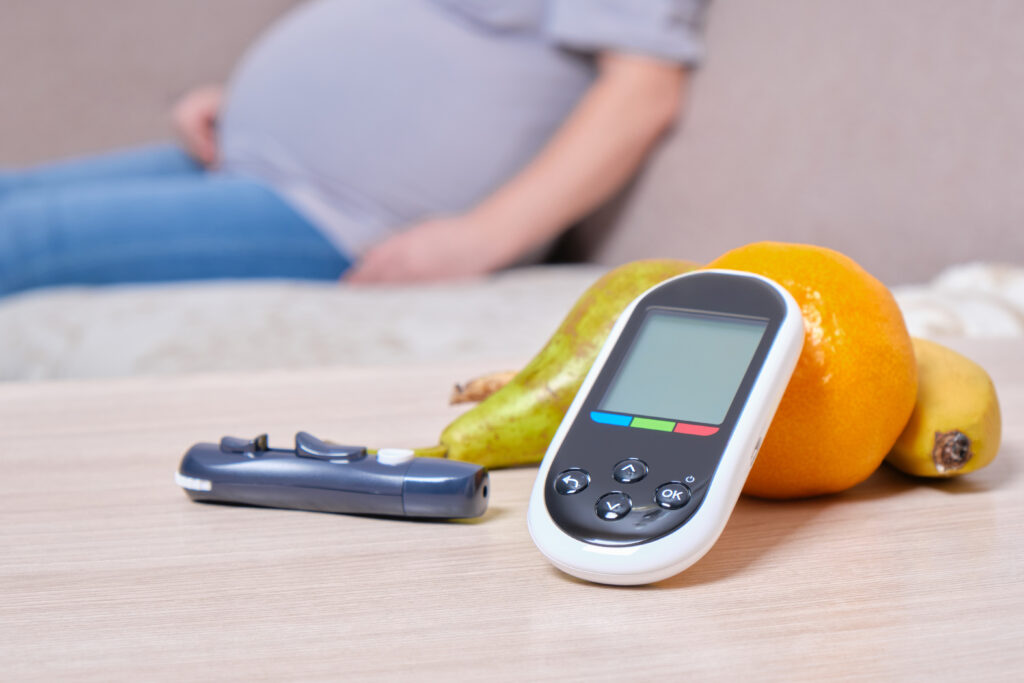Roughly 1 in 10 pregnant people will be diagnosed with gestational diabetes. While it can be a scary diagnoses, there are a lot of ways to manage gestational diabetes so that you can continue to have a healthy pregnancy. 
fruit and glucose meter on table, pregnant woman on sofa, blood sugar monitor
What is Gestational Diabetes:
We dont know for sure what causes gestational diabetes or why some people get it and some dont. What we do know is that some of the hormones from the placenta that help baby grow also block the action of the pregnant persons insulin in their body. Without enough insulin, glucose builds up in the bloodstream. Too much glucose can cause hyperglycemia .
The insulin cannot pass through the placenta to the baby, but the glucose does. This can cause rapid growth of fat for the baby.
Nutrition:
A well balanced diet of lean proteins, vegetables, fruit, and whole grains is paramount. Not only will this pack a nutrient punch it will also help keep your sugars in check. It is recomended to eat three well balanced meals with snacks in between.
A bedtime snack is also a great way to keep your sugars in check overnight. Keeping a consistent diet and schedule will keep your blood sugar from dipping and spiking throughout the day. Don’t forget to keep an eye on sugar substitutes. While some artificial sugar, like aspartame, are considered safe for gestatinal diabetes sugar alcohols, like sorbitol and xylitol, will spike your sugar level. They can also cause diarrhea and upset stomach. It is recomended to stay away from artificial sweetners alltogether. A dietitian can help you put together an easy to follow plan if you are having a hard time.
Exercise:
Moving your body every day is a great way to keep gestational diabeties under control. While moderate activity is the recommendation, not everyone is able to adhere to a strict workout routine. An easy 10-15 minute walk after dinner is perfect to get your body moving. Not only does exercise lower your blood sugar, it also makes your body more sensitive to insulin so you need less in the first place.
Before starting a new routine always check with your providers to find out what kind of physical activity is safe and what to avoid.
Medication:
Sometimes your blood sugar is not able to be controled with diet and exercise. When that happens your doctor will most likely prescribe you medication. The most common are Glyburide, Metformin, and Insulin. It is good to note that both Glyburide and Metformin can pass through the placenta to your baby while Insulin does not although all are considered safe for both you and baby. Talk to you provider about which of these medications are right for you.
Monitoring You:
It is advised that you test your blood sugar multiple times a day. This is done with a small drop of blood and a glucose monitor. To use most devices you will prick your finger using a special needle, and place a drop of blood on a test strip. The monitor will then test the amount of sugar in your blood.
Target blood sugar levels are:
- Before a meal: 95 mg/dl or less
- One hour after a meal: 140 mg/dl or less
- Two hours after a meal: 120 mg/dl or less
You can use a phone app to easily keep a record of your readings or write them down in a notebook. Whatever method you use, make sure to bring your notes with you to every prenatal appointment so your doctor can track and fluctuations.
Monitoring Baby:
Your provider will want to keep an on baby as well. Gestational diabetes can cause a large baby which can impact delivery. Newborns can also be at risk of breathing problems, poor glucose levels, childhood obesity, and higher risk of type 2 diabetes. There are a few very easy ways to monitor baby:
- Kick Counts: This is how often you feel your baby move. Find a quiet spot to lay down and focus on your baby. Every time your baby moves take note. This can be small movements or large movements. You should feel your baby move 10 times in one hour or less. Contact your provider if you don’t get 10 movements or if the number of movements change from one day to the next
- Non-Stress Test (NST): this is done in your doctors office during your visit. It is a kick count with the addition of monitoring baby’s heartrate. A belt with a sensor is placed around your belly to track the baby’s hear rate as they move.
- Biophysical profile (BPP): Similar to a NST, this test will monitor babys heart rate during an ultrasound. The provider will also measure baby’s breathing, movement, muscle tone, and amniotic fluid levles.
Have A Birth Plan:
Because the biggest risk of gestational diabetes is having a large baby an induction at 39 weeks or a c-section may be advised. Talk with your provider and discuss the risks and benefits as you near the end of your pregnancy. Having a doula on your birth team can also help you weigh through all of your options as you prepair for birth. It is important that both you and your newborn may be monitored after delivery as well.
Did you have Gestational Diabetes? How did it impact your pregnancy? Your birth? We would love to hear your story in our comment section!
